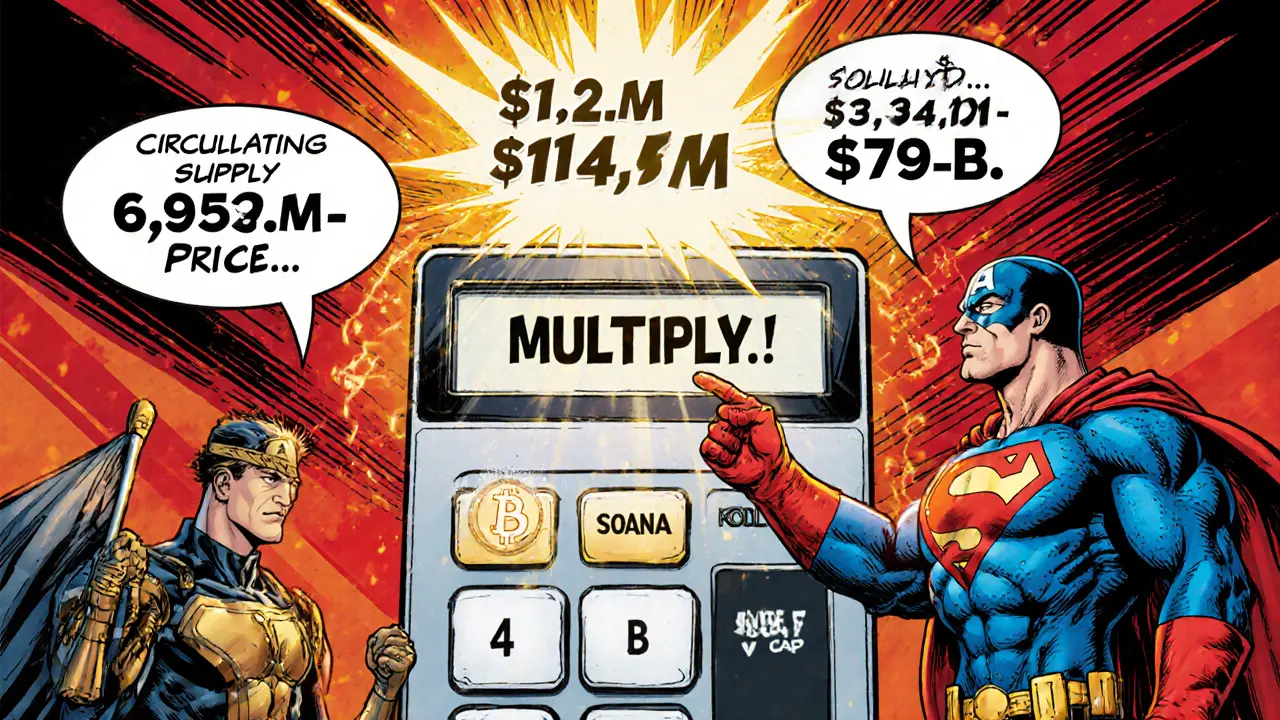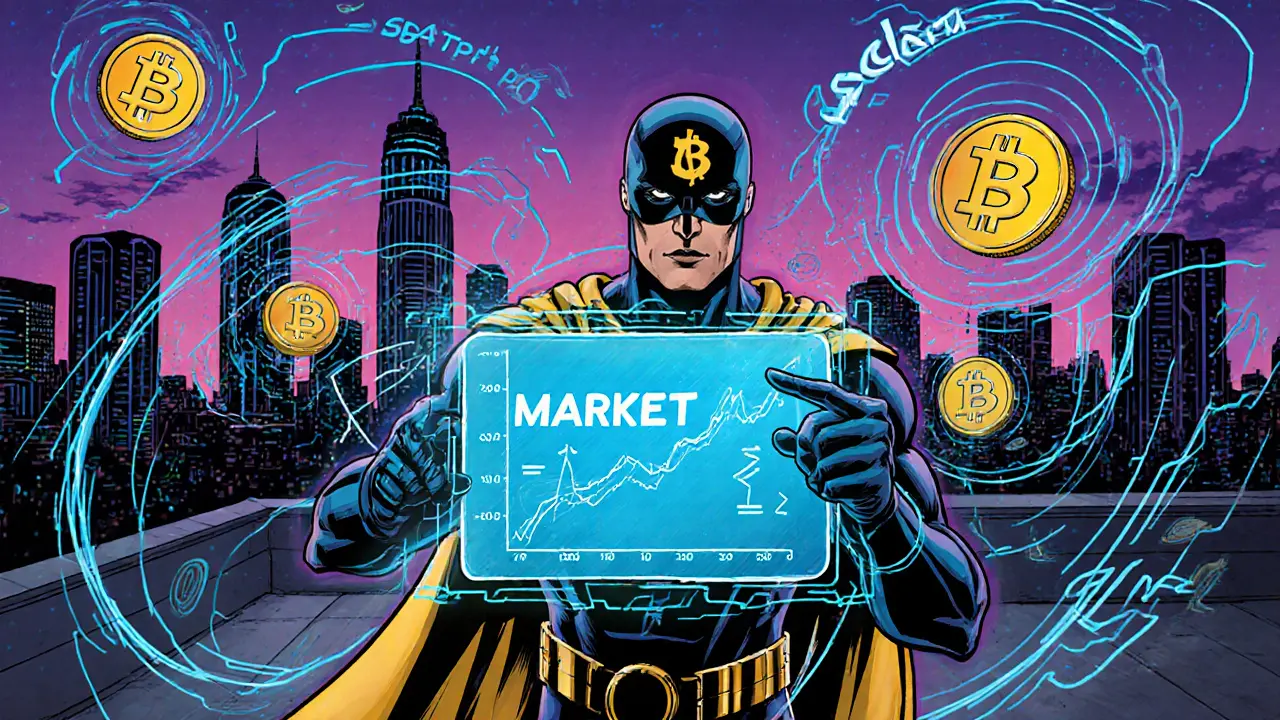Cryptocurrency Market Cap Calculator
Market Cap Result
How It Works
Market Cap = Circulating Supply × Current Price per Token
This simple formula gives you the total value of all circulating tokens in a cryptocurrency.
When you hear the term cryptocurrency market cap tossed around on crypto news sites, it can feel like jargon you need a finance degree to decode. In reality, it’s a simple number that tells you the total dollar value of all coins or tokens currently floating around. Knowing how it works helps you compare Bitcoin to a new meme coin, spot over‑ or undervalued projects, and decide how much risk you’re comfortable taking.
What is Market Capitalization in Cryptocurrency?
Market Capitalization is the total dollar value of all circulating tokens of a cryptocurrency, calculated by multiplying the circulating supply by the current price per token. The metric mirrors the stock market’s market cap, but it’s tailored to digital assets that can be minted, burned, or locked at any time.
How Is Market Cap Calculated?
The formula is straightforward:
- Find the Circulating Supply the number of coins or tokens that are publicly available for trading.
- Grab the current price per token from a reliable exchange.
- Multiply the two numbers: Market Cap = Circulating Supply × Current Price.
Because both price and supply change by the second, the market cap you see on a chart is a live snapshot, not a static figure.
Real‑World Examples
Let’s walk through two well‑known coins.
- Bitcoin the first and largest cryptocurrency by market cap has roughly 19.7million coins in circulation. At a price of $6,654.91, its market cap sits around $114.7billion.
- Solana a high‑performance blockchain focused on DeFi and NFTs counts about 534.6million SOL tokens in circulation. With each token priced at $147.90, Solana’s market cap is close to $79billion.
Both numbers fluctuate every few seconds as miners add new coins, traders shift prices, or projects burn tokens.

Why Market Cap Matters for Investors
Price alone can be misleading. A $1 token with 100million coins in circulation ($100million market cap) looks cheap, but a $100 token with 1million coins in circulation carries the same market cap and, arguably, a very different risk profile. Market cap lets you compare assets on a level playing field, regardless of token price or decimal precision.
Investors also use market cap to gauge stability. Large‑cap cryptocurrencies-those with market caps over $10billion-tend to be less volatile because moving the price requires massive capital inflows. Small‑cap and micro‑cap assets (< $1billion or < $100million) can swing wildly on modest trade volumes, offering higher upside potential but also higher risk of loss.
Market Cap Categories Explained
| Category | Market Cap Range | Risk Profile | Example(s) |
|---|---|---|---|
| Large‑Cap Cryptocurrency coins with market caps above $10billion | > $10billion | Lower volatility, institutional interest | Bitcoin, Ethereum |
| Mid‑Cap Cryptocurrency | $1billion - $10billion | Balanced risk/reward, growth potential | Solana, Cardano |
| Small‑Cap Cryptocurrency coins under $1billion market cap | < $1billion | High volatility, speculative | Many newer DeFi tokens |
| Micro‑Cap Cryptocurrency | < $100million | Extreme risk, can yield huge gains or total loss | New meme coins, niche utility tokens |
Supply Nuances: Circulating vs Fully Diluted
Two supply figures often cause confusion:
- Circulating Supply the number of tokens currently tradable on the market.
- Fully Diluted Supply the total number of tokens that will ever exist once all mining, vesting, and token issuance is complete.
Some platforms list both market caps-one based on circulating supply, another on fully diluted supply. For Bitcoin, the circulating cap uses ~19.7million coins, while the fully diluted cap would assume the 21million max supply, slightly raising the figure.
Projects also manipulate supply via token burns (permanently destroying tokens) or token unlocks (releasing previously locked tokens). These actions directly affect market cap: a burn reduces circulating supply, potentially boosting price, whereas an unlock expands supply and can dilute value.

Tools to Track Crypto Market Cap
Reliable data sources are critical because manual calculations are error‑prone.
- CoinGecko a cryptocurrency data aggregator that provides real‑time market cap rankings, category filters, and historical charts.
- CoinMarketCap another leading platform offering market cap data, fully diluted metrics, and customizable watchlists.
Both sites pull price feeds from major exchanges and adjust supply numbers based on project announcements, giving you a near‑instant view of market dynamics.
Common Pitfalls and How to Interpret Market Cap Correctly
Even though the formula is simple, misreading market cap can lead to poor investment decisions.
- Methodology mismatch: Some sites use circulating supply, others use fully diluted supply. Always check which figure you’re looking at.
- Supply‑side tricks: Projects may lock a large portion of tokens, inflating the market cap artificially. Look for the proportion of tokens that are actually tradeable.
- Liquidity blind spot: A high market cap doesn’t guarantee you can buy or sell large amounts without slippage. Check trading volume alongside market cap.
- Index weighting confusion: When a crypto index uses market‑cap weighting, it can overweight large‑cap assets, skewing performance metrics.
Cross‑checking multiple data sources and reviewing tokenomics documentation can mitigate these issues.
How Market Cap Shapes the Wider Crypto Ecosystem
Beyond individual investors, market cap drives many institutional and regulatory decisions.
- Index providers create market‑cap‑weighted baskets, enabling passive exposure to the crypto market.
- Fund managers set minimum market‑cap thresholds (e.g., only assets > $500million) to manage risk.
- Regulators sometimes apply different rules based on market‑cap size, treating large‑cap tokens more like securities.
- The total crypto market cap-a sum of all assets-acts as a macro‑indicator of sector health, similar to the total stock market cap for equities.
Understanding these dynamics helps you see why market cap is more than a number; it’s a key building block of the crypto financial infrastructure.
Frequently Asked Questions
What does “market cap” mean for a cryptocurrency?
It’s the total dollar value of all tokens that are currently in circulation, calculated by multiplying the circulating supply by the current price per token.
How is circulating supply different from total supply?
Circulating supply counts only the coins you can actually trade on exchanges. Total supply includes locked, vested, or unissued tokens that aren’t available to the market yet.
Why do some sites show two market‑cap numbers for the same coin?
One figure uses circulating supply, the other uses fully diluted supply (all tokens that will ever exist). The methodology affects the final value, so always check which one you’re viewing.
Can market cap predict price movements?
Not directly. Market cap reflects current price and supply, but price can change for many reasons-news, adoption, macro trends. Use market cap together with volume, sentiment, and technical analysis for a fuller picture.
Is a higher market cap always safer?
Higher market cap usually means more liquidity and less price volatility, but it doesn’t guarantee safety. Regulatory, technical, or governance issues can affect any asset regardless of size.


Liam Wells
October 8, 2025 AT 09:14The purported significance of market cap is grossly overstated; indeed, one must consider the underlying tokenomics, supply dynamics, and liquidity constraints, lest one be misled by superficial figures!
Nicholas Kulick
October 10, 2025 AT 16:48Market cap is simply circulating supply multiplied by price; use sites like CoinGecko for real‑time data.
Kate O'Brien
October 13, 2025 AT 00:21They don’t want us to know that the big exchanges are secretly printing tokens behind our backs.
Ricky Xibey
October 15, 2025 AT 07:54Yo, love the calculator – just plug in the numbers and boom, you’ve got the cap!
Sal Sam
October 17, 2025 AT 15:28From a valuation perspective, market cap serves as a proxy for aggregate enterprise value, albeit lacking adjustments for on‑chain velocity and token burn rates.
Moses Yeo
October 19, 2025 AT 23:01Ah, the illusion of size!; market cap is but a veil that masks the true entropy of decentralized economies; question everything!
Lara Decker
October 22, 2025 AT 06:34Your reliance on raw market cap ignores the liquidity abyss that lurks beneath; depth matters more than sheer dollars.
Anna Engel
October 24, 2025 AT 14:08Oh sure, because a $10 billion number instantly makes a coin safe – as if investors are that naïve.
manika nathaemploy
October 26, 2025 AT 21:41i think its cool u can see how the supply changes affect the price but watch out for fake data.
Marcus Henderson
October 29, 2025 AT 05:14It is incumbent upon investors to juxtapose market capitalisation with trading volume in order to ascertain liquidity adequacy.
Jack Stiles
October 31, 2025 AT 12:48yeah, volume tells ya if you can actually buy or sell without moving the price too much.
Ritu Srivastava
November 2, 2025 AT 20:21The crypto hype machine feeds on uninformed masses; educating them about market cap is a moral imperative.
Darren Belisle
November 5, 2025 AT 03:54Indeed; market cap is a useful metric, yet it should never be the sole compass guiding one’s investment decisions!
Heather Zappella
November 7, 2025 AT 11:28For accurate figures, consult both CoinMarketCap and CoinGecko, as they sometimes differ in circulating versus fully diluted supply.
Jason Wuchenich
November 9, 2025 AT 19:01While both platforms are valuable, always cross‑verify with the project's official tokenomics documentation.
Caitlin Eliason
November 12, 2025 AT 02:34Understanding market cap is like learning a new language in the chaotic world of crypto.
Every token’s price multiplied by its circulating supply yields a number that many mistakenly treat as a guarantee of safety.
Large‑cap coins such as Bitcoin and Ethereum enjoy deep order books, which dampens price swings on modest trades.
However, even they are not immune to macro‑economic shocks that can erode billions of dollars in value overnight.
Mid‑cap projects often sit in a sweet spot, offering growth potential while retaining enough liquidity to avoid extreme slippage.
Small‑cap and micro‑cap assets, on the other hand, can double or collapse within hours, especially when the community buzz fades.
Investors should therefore assess not just the headline market cap but also the token’s distribution, vesting schedules, and any locked reserves.
A token with 90 % of its supply held by a single entity poses a centralisation risk that the headline number masks.
Burn events can artificially inflate market cap by reducing supply, but they do not necessarily improve the underlying utility.
Conversely, token unlocks can dilute value, turning a previously stable coin into a volatile gamble.
Liquidity metrics such as the 24‑hour volume to market‑cap ratio give a clearer picture of tradeability.
Regulatory scrutiny often intensifies for assets exceeding certain market‑cap thresholds, adding another layer of risk.
Moreover, institutional participation tends to stabilise large‑cap assets but can also lead to herd‑like behaviour during market corrections.
In practice, a diversified portfolio spanning several market‑cap categories mitigates the extremes of both volatility and stagnation.
Ultimately, market cap is a starting point, not a finish line; diligent investors combine it with on‑chain analytics, community sentiment, and fundamental research.
Ken Pritchard
November 14, 2025 AT 10:08Great points, Caitlin; diversifying across caps indeed balances risk and reward.
Brian Lisk
November 16, 2025 AT 17:41When constructing a crypto portfolio, one should begin by categorising assets according to their market capitalisation, as this provides a macro‑level view of the ecosystem.
Large‑cap cryptocurrencies tend to exhibit lower volatility due to their entrenched network effects and institutional backing.
Mid‑cap assets, while more volatile than their larger counterparts, often present compelling upside as they capture emerging use‑cases.
Small‑cap and micro‑cap tokens, however, are akin to speculative bets, where the potential for exponential returns is accompanied by a high probability of total loss.
Liquidity considerations are paramount; a token with a respectable market cap but negligible daily volume may be impossible to exit without severe price impact.
Furthermore, one must examine tokenomics, including vesting periods, supply caps, and burn mechanisms, as they directly influence future market cap trajectories.
Cross‑referencing data from multiple aggregators, such as CoinGecko and CoinMarketCap, helps to reconcile discrepancies in circulating versus fully diluted supply figures.
Finally, integrating on‑chain metrics like active addresses and transaction volume can illuminate the underlying health of a project beyond mere market‑cap numbers.
EDWARD SAKTI PUTRA
November 19, 2025 AT 01:14I appreciate the thorough breakdown, Brian; keeping an eye on both on‑chain activity and external data sources can really sharpen one's analysis.
Bryan Alexander
November 21, 2025 AT 08:48The crypto landscape is a living, breathing organism, and market cap is simply its heartbeat – feel the pulse, and you'll know when to ride the wave!
Patrick Gullion
November 23, 2025 AT 16:21Honestly, I think people obsess over market cap too much; sometimes a low‑cap gem with a passionate community can outperform the giants.